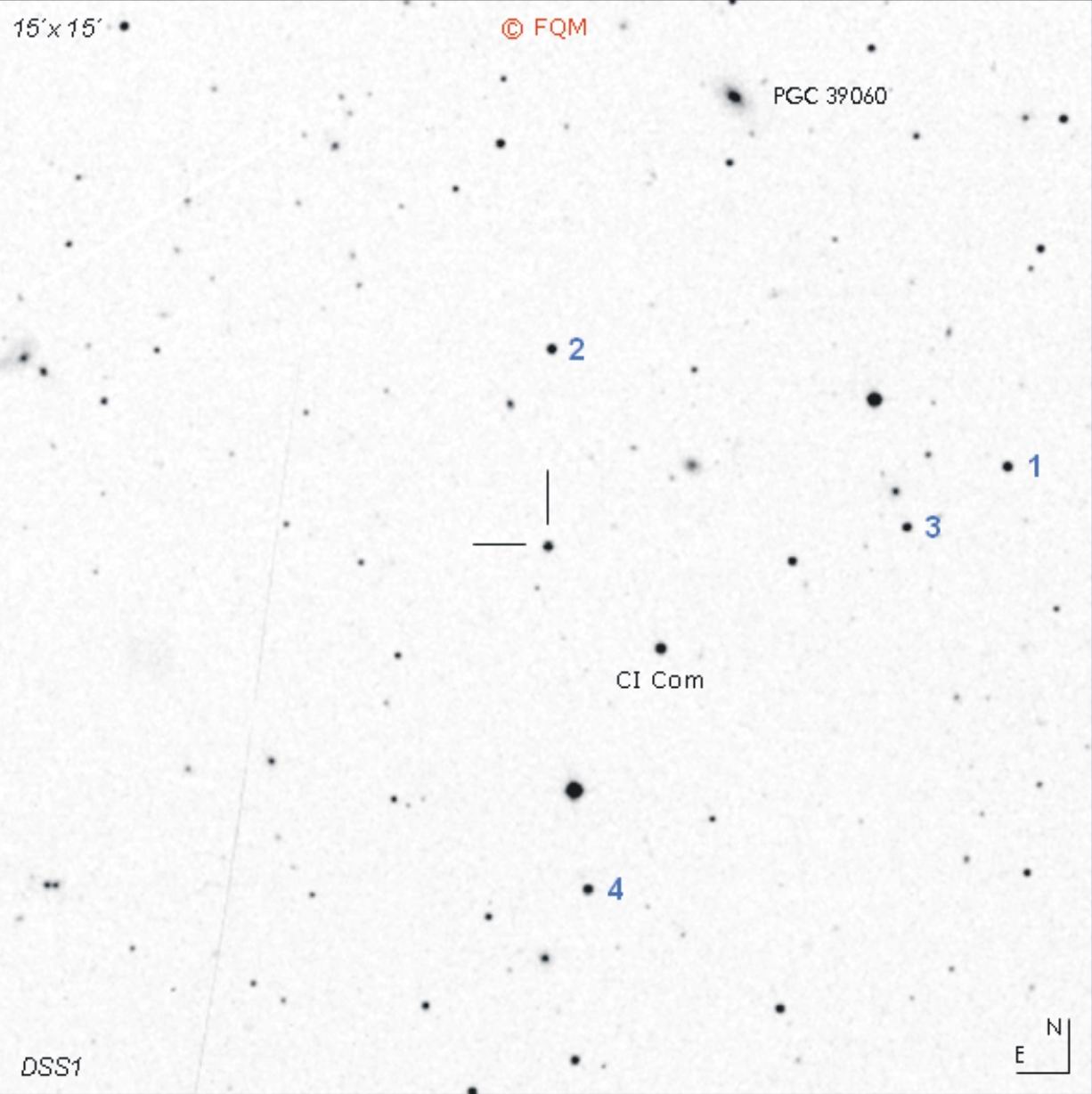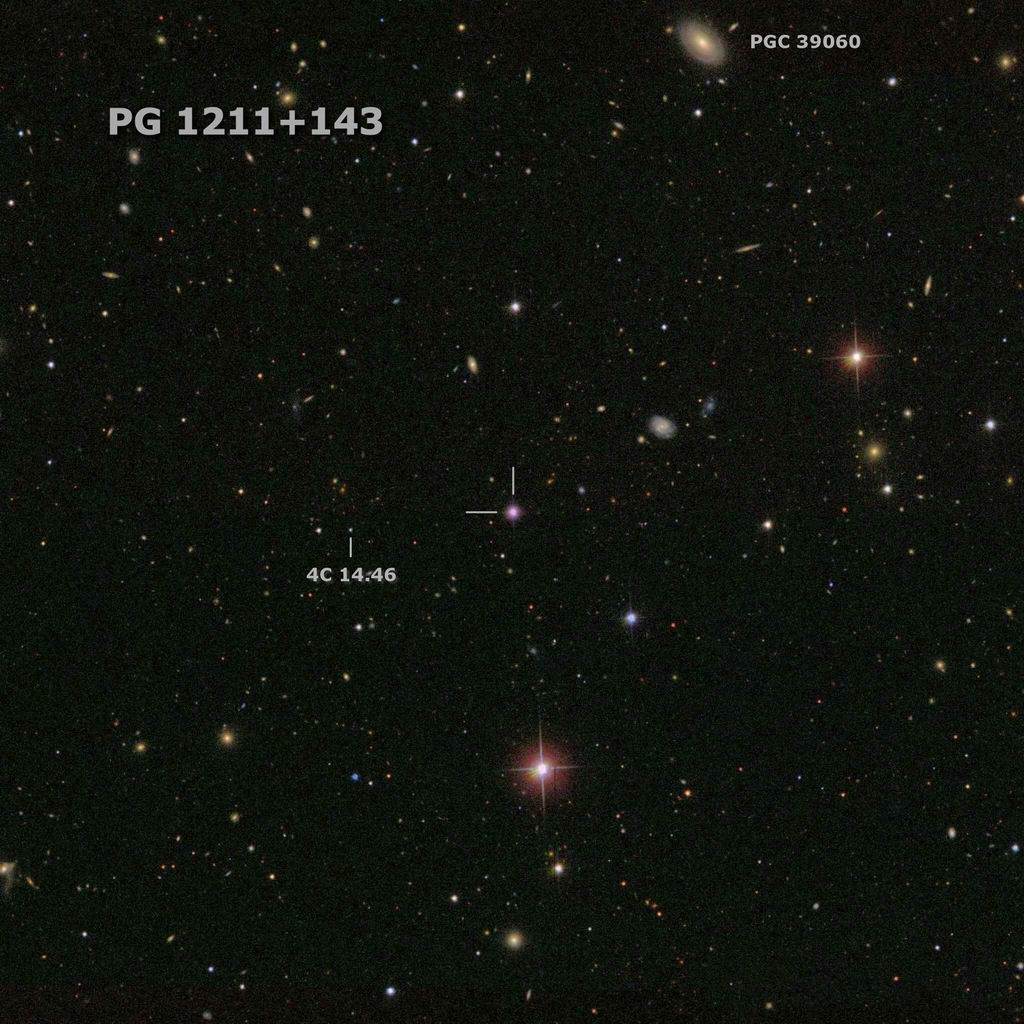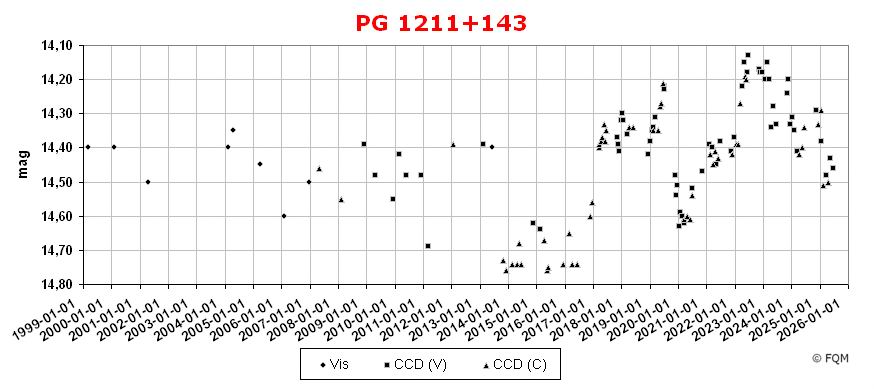
| Frankfurt Quasar Monitoring |
| PG 1211+143 |
| Cross-Identifications | 1ES 1211+143, RX J1214.3+1403, QSO B1211+143 XSS J12164+1427, 2E 1211.7+1419, 1211+143 PB 3894, PGC 39086, LEDA 39086, RBS 1081 SDSS J121417.70+140313.0, 2E 2620 |
| Equat. coordinates | RA 12 14 17.7 DE +14 03 13 (J2000) |
| Constellation | Coma Berenices |
| Type | QSO |
| Redshift | z=0.080 |
| Distance (2) (3) |
331 Mpc |
| Total mag range (mv) (4) (5) | 13.9 - 14.8 |
| Catalog Magnitude (1) | 14.19 |
| Absolute Magnitude (1) | -24.0 MB |
| Light Travel-Time (2) | 1.038 × 109 yrs |

Comparison stars
| star | B | V |
| 1 | 15.114 (0.058) |
14.526 (0.043) |
| 2 | 15.332 (0.042) |
14.601 (0.027) |
| 3 | 15.826 (0.059) | 15.015 (0.040) |
| 4 |
15.952 (0.037) | 15.242 (0.023) |


| PG
1211+143
is a bright radio-quiet quasar in south-western Coma
Berenices, close to the constellation Virgo. Quasar
PG
1211+143 is
located in the far cosmological background of the western part of the
Virgo galaxy cluster - only about 1° away from the bright galaxies M
98, M
99 and NGC 4216. PG 1211+143 was discovered as a "blue stellar object" in the 1970s by the Palomar-Berger Blue Star Survey (PB). With the same optical property, it was also cataloged by the Palomar-Green Bright Quasar Survey (PG). Follow-up spectroscopy led to the quasar classification (NLS1-spectrum). Gravitational interaction with a close companion galaxy seems to be responsible for the quasar activity. The mass of the central supermassive black hole of 1211+143 is considered as 4x107 solar masses. In the 1980s, this quasar was identified as an X-ray source by the Einstein satellite (1ES). Furthermore, PG:1211+143 was also observed by the International Ultraviolet Explorer IUE. PG 1211+143 is a low amplitude variable object, ranging between 13m.9 - 14m.8. For visual observers with telescopes of 8- to 10-inch of aperture this quasar is a nice observing target. It appears as a stellar object even with large aperture telescopes. Finding PG 1211+143 is an easy task through its position close to a star pattern dubbed the "T", consisting of a group of mag 6 stars, including star 6 Com. CCD observers, as well as visual observers, shall use the comparison stars given above. ____________
In case you look for another bright quasar you may turn to PG 1116+215, a bright 14-mag object at a distance of about 2×109 light-years, 15° NW of PG 1211+143. CCD observers may identify another quasar in their frames: 4C 14.46, only 2´W of PG 1211+143 (see colour chart above). Quasar 4C 14.46 is a faint 19-mag stellar object with a redshift of z=1.28 (data based on Véron-Cetty et al. 2010). The star field around quasar PG 1211+143 is peppered with bright galaxies as we look towards the western part of the Virgo galaxy cluster. The bright galaxies M98, M99 and NGC 4216 are only about 1° away, respectively. The nearest bright galaxy is Sc-spiral NGC 4208 (11m.8), only 20´ away to the SW. By turning 4.3° to the SW we find ourselves at the centre of the Virgo galaxy cluster, marked by M87, a giant elliptical which contains a supermassive black hole of approximately 6.5×109 solar masses. Observers with large aperture telescopes may also recognize the famous jet, emerging from the brilliant active centre, reaching out some few arcseconds to the NE. Steady air and high magnification are required. Cruising around the numerous galaxies of Virgo cluster is a pleasure. You shall use a telescope of at least 8-inch of aperture or larger. |
| Barbieri, C., Romano, G. 1984, AcA, 34, 117; Optical variability of 14 quasistellar objects. Bechtold, J., Czerny, B., et al. 1987, ApJ, 314, 699; X-ray spectra of PG quasars. II - The X-ray-ultraviolet excess of PG 1211+143. Berger, J., Fringant, A.M. 1977, A&AS, 28, 123; A search for faint blue stars in high galactic latitudes. I. Nine PSS fields near the north galactic pole. Boroson, T.A., Green, R.F. 1992, ApJS, 80, 109; The Emission-Line Properties of Low-Redshift Quasi-Stellar Objects. Clements, D.L. 2000, MNRAS, 311, 833; Far-infrared-loud quasars - I. Disturbed and quiescent quasars in the PG survey. Elvis, M., Wilkes, B.J., McDowell, J.C. 1994, ApJS, 95, 1; Atlas of quasar energy distributions. Giveon, U., Maoz, D., et al. 1999, MNRAS, 306, 637G; Long-term optical variability properties of the Palomar- Green quasars. Hansen, T. 1991, Deep Sky Magazine 34, 32; The "Deepest" Deep Sky Objects. Karge, S.; Helle Quasare für 8- bis 10-Zoll Teleskope. Ein Beobachtungsführer zur visuellen Beobachtung von Quasaren und BL Lacertae Objekten; Frankfurt 2005. Kaspi, S., et al. 2000, ApJ 533, 631; Reverberation Measurements for 17 Quasars and the Size-Mass-Luminosity Relations in Active Galactic Nuclei. Schmidt, M., Green, R.F. 1983, ApJ, 269, 352; Quasar Evolution derived from the Palomar Bright Quasar Survey and other complete Quasar Survey. Schmidt, M., Green, R.F. 1986, ApJ, 305, 68; Counts, evolution, and background contribution of X-ray quasars and other extragalactic X-ray sources. Soifer, B.T., Neugebauer, G., et al. 1981, ApJ, 243, 369; Infrared and optical observations of the hydrogen lines in quasars. Steinicke, W.; Katalog heller Quasare und BL Lacertae Objekte; Umkirch 1998. Steinicke, W.; Beobachtungsliste für helle Quasare; Umkirch 1999. Véron-Cetty, M.-P., Véron, P. 2001, A&A 374, 92; A Catalogue of Quasars and Active Nuclei: 10th edition. Véron-Cetty, M.-P., Véron, P. 2003, A&A 412, 399; A Catalogue of Quasars and Active Nuclei: 11th edition. Véron-Cetty, M.-P., Véron, P. 2006, A&A 455, 776; A Catalogue of Quasars and Active Nuclei: 12th edition. Véron-Cetty, M.-P., Véron, P. 2010, A&A 518, 10; A Catalogue of Quasars and Active Nuclei: 13th edition. Wilkes, B.J., Kuraszkiewicz, J., et al. 1999, ApJ, 513, 76; Investigation of the Relation between the Spectral Energy Distributions and the Emission Lines in Low-Redshift Quasars. |
| Links: Sloan Digital Sky Survey |
| home |